Fresco in the kitchen: original ideas and examples

When decorating kitchens, many owners choose designs that stand out for their beauty and uniqueness. One such solution is a fresco. This art, which came from antiquity, has not yet lost its popularity. That is why in modern kitchens you can increasingly see elegant painting, which each owner can choose to his liking.




Features of technology
A fresco is a painting that was popular in antiquity, it was used to decorate the palaces of ancient kings and influential people around the world. To create a fresco, it was necessary to have remarkable patience, as well as talent, because all the painting was created exclusively by hand. To allow themselves such a luxury, the nobles hired the best artists who brought such masterpieces to life. Today, traditions have changed a little, so anyone can create a beautiful fresco in their kitchen.
However, before choosing this option for yourself, you need to study various creation techniques and their features.




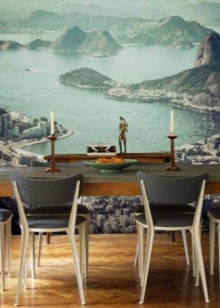
Raw plaster
The very first, classic version involves applying a pattern to raw plaster. To make a similar design, the master applies embossed plaster, and then gives it the desired shade. After that, a drawing is created, and the image is painted with paints. Such a fresco can be made according to an individual order; the owner of the kitchen chooses any drawing. Subsequently, the image is subject to restoration, it can be washed and wiped.
Nevertheless, such a painting will cost a lot, and the owners of the premises will have to monitor the correct temperature in the kitchen and avoid high humidity.
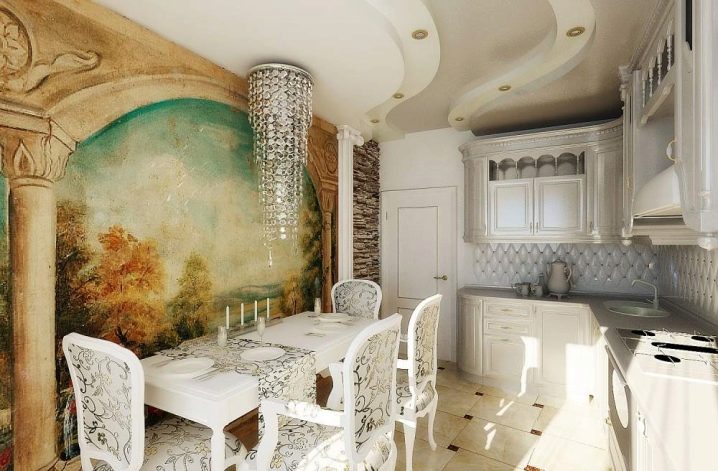
On canvas
To get an interesting image on canvas, a different technique is used. Sand is mixed with lime, this mixture is applied to the wall. Then they wait for drying and paint the wall. In addition, there is an opportunity to purchase a ready-made canvas and simply "plant" it on the wall.
A mural on canvas is one of the easiest methods to create a drawing, however, it will take some effort to maintain. Such a pattern will need to be regularly wiped with a damp cloth.


Wallpaper with a pattern
Of course, this is not a real classic fresco, but if there is no opportunity or desire to look for a master, you can buy non-woven wallpaper, which will practically not differ from natural frescoes. Such a "fresco" is glued to the glue intended for wallpaper. And what is important, the owner of the kitchen still has a place for creativity - if it seems to you that the image is missing something, any detail can be completed independently.


Wallpaper
The easiest and most budgetary option for decorating a kitchen is to buy a photo wallpaper. They are easy to apply on their own, they can bring to life any chosen drawing. However, there is a serious drawback here - wallpaper can only be applied on ideal surfaces. Therefore, first you have to align and plaster the walls.



Advantages and disadvantages
A beautiful fresco is a great option for how you can decorate your kitchen in an unusual way. At first glance, it may seem that this technology has no drawbacks at all, but it is not. Let's dwell on the advantages and disadvantages of frescoes in more detail. Among the advantages are the following points.
- Most of the frescoes perfectly tolerate various external factors: humidity, temperature changes, exposure to ultraviolet radiation.This is due to the materials that are applied to the image after it is completed.
- If you have skills in painting, as well as when a professional master gets down to business, it is safe to say that the drawing will last a very long time and will delight the owners for several decades. In addition, once a drawing begins to lose its color, it can be successfully restored.
- An image for a fresco can be unique and even one of a kind. You can find any photo on the Internet, order a drawing of your dreams from an artist, and also transfer your favorite photo directly to the wall.

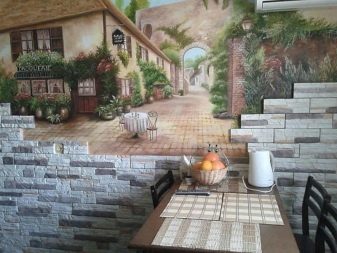


There are very few drawbacks to frescoes, but you need to talk about them too.
- The first minus is the price, especially for those techniques where painting is created using the classical method. As a rule, applying a pattern to raw plaster will require a lot of time and effort from the master, and the cost for the work will be very high.
- The second drawback is the need for proper care. Frescoes should be regularly wiped clean, making sure that there are no drops of oil and grease on them, so that water does not get into. For the most part, this applies to cheap options such as non-woven or photo wallpaper.



Selecting a pattern
Before you start creating a fresco in your kitchen, you need to use some tips to help you get the drawing right.
- If your kitchen is small, it is not worth choosing a 3D image. The effect of such drawings will visually reduce the room, create an overload of the interior with details.
- Discard overly saturated images. The abundance of bright colors is appropriate for the living room, but not for the kitchen. The brightness will tire, annoying both the hosts and their guests.
- For small sizes, abstract drawings or optical illusions will be appropriate, which will allow you to get a kind of "continuation" of the kitchen, forcing it to get lost in infinity. But for large rooms, whatever you want is suitable.
When decorating a fresco in the kitchen, it is also very important to take into account the stylistic direction of this room.



Classic
The features of the classic style are severity and restraint, along with luxury and light pretentiousness. The selected images must clearly correspond to the direction. For classicism in its primary hypostasis, reproductions of paintings by artists of the Renaissance, ancient painting, intricate mosaic patterns, heroes and mythical creatures of Ancient Greece and Rome will be appropriate.
If you decide to "modernize" the classics a little, sea and mountain landscapes, still lifes with images of fruits, photographs of ancient cities will be an excellent solution.
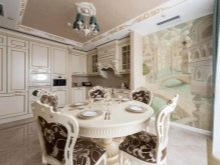


Loft
Loft style, like high-tech, is a real mixture of glitter and light. Among steel, wood and chrome surfaces, a fresco will be more than appropriate, but it must meet the canons of style. Severity, clarity and consistency are welcomed. Images of modern cities, skyscrapers, macro photography, photographs of transport, drawings, abstract strict drawings become a good idea here.

Provence
Provence is a style chosen by people who appreciate home warmth and comfort. Country is rightfully considered a "relative" of this direction, therefore we will consider drawings for these styles at the same time. Rustic styles will require rural images from their owners. For example, it can be a photo of a quiet, calm pond, pasture with cows, sheep or horses, a classic village house with a cozy courtyard.
Pastoral images, spacious fields with poppies and lavender, landscapes, seashores and oceans are also welcome. When choosing such frescoes, do not forget to complement the interior of your kitchen with other elements typical of Provence: bouquets of flowers, knitted openwork napkins, wooden chairs, beautiful embroidered tablecloths, all kinds of plates and cups in white and pink tones.

Ethno
Images from the life of Eastern peoples are the best fit for bright, extravagant personalities who adore the richness and riot of colors. If you like Africa in its classic form, pick up drawings of elephants, savannahs, ancient cave paintings for yourself. Desert animals look very beautiful.
People who are interested in Ancient Egypt will love hieroglyphs, pyramids, pharaonic masks, desert landscapes. Those who like the cultures of China and Japan will love Japanese pagodas, sakura, photographs of bamboo, pandas, ancient buildings, weapons.

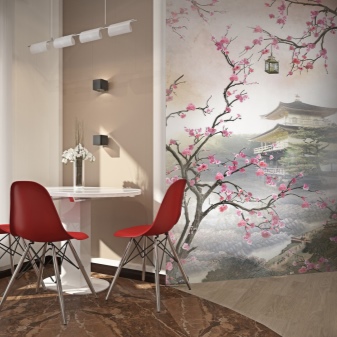
Original solutions
An interesting and beautiful solution for a classic-style kitchen will be a fresco depicting a calm river or sea landscape. Live plants and discreet lighting will complement such an interior.

Photographs of cities and landmarks are very elegant in the classics. For example, drawing a beautiful building under an arch or a Venetian street filled with water will delight any art lover.


In addition, mini-frescoes depicting ancient vases and amphorae are ideal for a classic kitchen.

Images of the city are inherent not only in the classics, but also in modern times. Such an autumn landscape looks elegant and calm. The unusual shape of the chandelier, as well as soft white chairs, allow the interior to acquire completeness.

But the white and blue kitchen with a small amount of black elements will sparkle with new colors if you place in it a fresco depicting spring Paris.

In this modern kitchen filled with glitz, a black and white urban mural is the perfect solution.

Softer in color, cream kitchens will look completely different when you add cute window murals to them.

A wall painting depicting horses would be a chic idea.

And this fresco, where horses seem to be a continuation of splashes of milk and hot chocolate, perfectly complements the black and yellow colors and French volumetric windows.
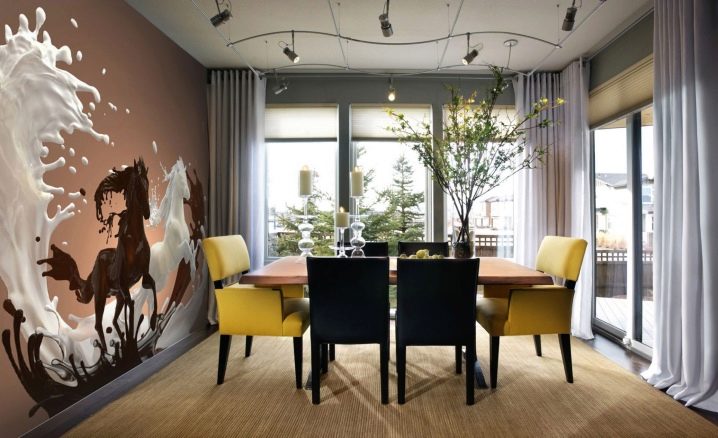
The next video is devoted to the intricacies of installing a fresco.













The comment was sent successfully.